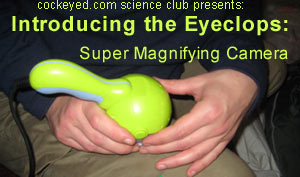

 |
|
 |
page 1
Anne Nester sent a tantilizing spread of yarns from a variety of places. She wasn't sure that they would be "interestingly different" at the micro level. They ranged in thickness from the wide purple #9 to the thin-as-floss #1. I took close-up photos and eyeclops shots below, from strand 1 to 12. |
The first were two snips from the same batch of hand-spun yarn. She believed this was single-ply, a blend of sheepswool and dog hair, and was spun with a drop-spindle. One sample has a colored stripe.
|
Closeup of #1.
|
Same structure, solid color. |
Closeup. The fibers seem less twisted, and this part is a little wider than the striped version.
|
The second sample was wool directly from a Jacob's sheep, shorn at her friend's farm in southern Pennsylvania in early March. She advised me that it may still have enough lanolin in it to leave a grease spot on the paper, but I didn't detect one.
|
Raw wool fibers under the view of the Eyeclops. |
Sample #3 was an orange three-ply acrylic commercial yarn.
|
Closeup. |
Sample #4 was a commercially-spun green 50-50 blend of wool and kid mohair.
|
Closeup.
|
Sample five was something I hadn't seen before, a purple, feathery "eyelash" acrulic yarn with shiny silvery fibers.
|
A closeup revealed that the silver fibers were translucent, almost like kelp. |
Another shot of the eyelash yarn.
|
The sixth sample was a pale blue rayon yarn, made by a small fiber-arts place in North Carolina.
|
This yarn was super shiny and beautiful at high magnification. |
Another closeup of the blue rayon.
|
Sample seven was a blue acrylic fuzzy "chenille" yarn, commercially spun. |
This chenille looked soft, even at high magnification. usually fluffy stuff is hard to get in focus, but this thread had a very uniform pile length, so I could get a big patch all in focus at the same time. Under magnification it looked like a four-foot deep shag carpet.
|
Sample eight was a purple wool yarn with other fibers (from Noro, a japanese company that makes crazy yarns with lush colors and interesting mixes of fibers). |
This was tough to photograph under magnification, but it was obvious that this yarn had a lot of colors going on in there.
|
Sample nine was a single-ply 65-15 wool-mohair blend, commercially spun (Lamb's Pride Bulky, big operation). This yarn was about as big as the cord to my printer.
|
A terrible photo, just not in focus.
|
Sample ten was a red and yellow, two-ply, handspun with a drop spindle.
|
A closeup of where red meets orange. I realize the colors are different in this picture. The eyeclops sometimes skews the colors of things a bit.
|
Sample Eleven was two-ply alpaca, commercially spun at Frog Tree Yarn, Bolivia. |
Closeup of alpaca.
|
And finaly, sample twelve, a red 70-30 wool-mohair blend, dyed adn spun by Green Mountain Spinnery in Vermont (small operation).
|
A closeup.
|
That's it! Here again is the 8.5x11 sheet of paper she taped these to, in case you lost track of how large these yarns are. The Eyeclops is a champ at textiles. Thanks Anne, for sending so many samples, and for providing such a nice description of them all.
Send me items, and I'll use the Eyeclops to look VERY closely at them, and I'll post a photo here, on Cockeyed.com. Detailed things: I won't return anything I get, so please don't send your favorite Tiki charms or Scrabble tiles. |
Discovering new Velcro Closures with the Eyeclops | Introducing the Eyeclops, super magnifier! | Reader contributions for the Eyeclops | How much is inside Thread Count?
contact Rob | how much is inside a keg | height weight chart | how much is inside goldschlager | backwash